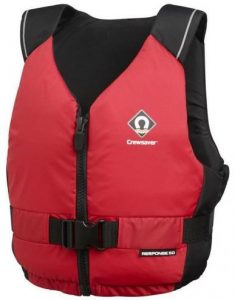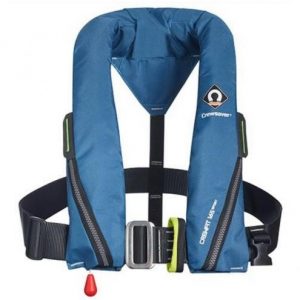All members should make themselves familiar with the main water safety aids and know how to use them in case of emergency. All members should also take responsibility for storing and maintaining these items so that they are available when needed. All coxes and safety boat users must wear a Personal Flotation Device (buoyancy aid or lifejacket) at all times when on the water.
The club has a mix of Buoyancy Aids (foam-filled jackets that do not require inflation) and manually inflating lifejackets (which inflate when a toggle is pulled); in a bow-coxed boat a lifejacket must be worn rather than a buoyancy aid, and this is also recommended for launch and safety boat drivers.
Using a buoyancy aid

Before use check:
- Is this the right jacket to use? (In a bow-coxed boat you MUST wear a lifejacket not a buoyancy aid)
- Is it the right weight for me?
- Are all the straps etc intact?
Make sure it is correctly fitted and there are no trailing straps
After use hang it up carefully and let it dry
Using a lifejacket

Before use check:
- Is this the right jacket to use?
- Is it the right buoyancy rating? (100N for users under 40kg, otherwise 150N or greater)
- Are all the straps etc intact?
- Are the gas cylinder and its toggle safely stowed?
Make sure it is correctly fitted and there are no trailing straps
Do NOT pin crew numbers or anything else through the fabric
After use hang it up carefully and let it dry
Using a throwline
First check for danger (other boats or floating hazards).

Pull the first few metres out of the bag; make sure it runs freely. Wrap the end of the rope round your non-throwing hand (your left hand if you are right-handed). Make sure you are standing securely and throw the bag as far as you can past, and ideally upstream of, the swimmer; an underarm action is usually better unless you are really good at throwing overarm. Tell them to roll onto their back and put the line over their shoulder; then draw them towards you until you can pull them in.
Using a space blanket

If a sculler/rower has fallen in, or just become too cold in the boat, a space blanket can help to reduce the heat they lose into the air. Unwrap and unfold the blanket and wrap it right round the person, and over their head. If you have spare warm and dry clothes, these may be at least as effective.
Maintenance
Personal Flotation Devices must be checked every three months and a record kept. For lifejackets check:
- all webbing, stitching, buckles and zips are in good order
- the CO2 cylinder has not been fired, is free from corrosion and is screwed up tightly
- the inflation bladder should be checked for leaks by inflating orally, or by hand pump to avoid moisture build-up inside, and left inflated for 24 hours to ensure there are no leaks and pressure is maintained
Buoyancy aids must:
- Carry the EN approval mark and user weight
- Be correctly rated for the weight of the user (there are specific jackets for adults)
- Be in good condition and not damaged
Throwlines should be thrown and re-packed securely once a year.
